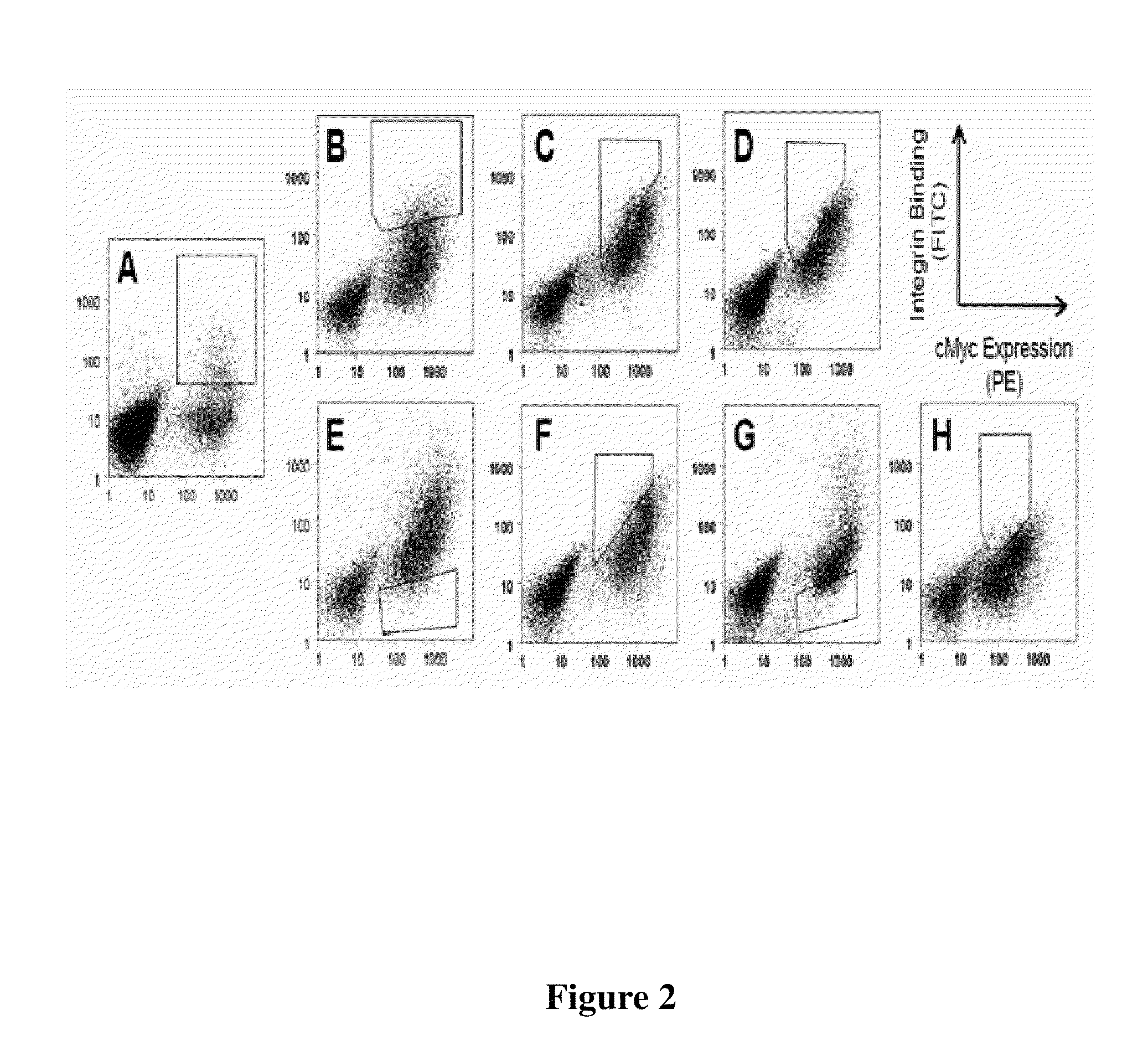Cystine knot peptides binding to alpha IIb beta 3 integrins and methods of use
a technology of integrins and cystine knots, which is applied in the field of integrin binding peptides, can solve the problems of difficult generation of rgd-containing protein ligands that selectively target only a single integrin with high affinity, and long been a significant molecular engineering problem, so as to prevent platelet aggregation and high binding
- Summary
- Abstract
- Description
- Claims
- Application Information
AI Technical Summary
Benefits of technology
Problems solved by technology
Method used
Image
Examples
example 1
Materials and Methods
Library Synthesis and Screening
[0103]The AgRP loop 4 random library was prepared as described in J. Mol. Biol. 385, 1064-1075. Briefly, the AgRP gene was assembled by overlap extension PCR using Taq polymerase in the presence of DMSO. Primers were used that contained NNS degenerate codons in place of loop 4, where N=A, C, T or G and S=C or G, which codes for all 20 amino acids and the TAG stop codon. The assembled gene was PCR amplified using end primers with 40 bp overlap to the pCT vector upstream and downstream of the NheI and BamHI restriction sites for homologous recombination in yeast. Digested pCT vector (0.5-1 μg) and amplified linear gene product (5-10 μg) were electroporated into the S. cerevisiae strain EBY100, yielding a library of ˜2×107 transformants. See Nat. Biotech. 15: 553-557, regarding EBY100.
[0104]The yeast library was grown in selective media (SD-CAA, 20 g / L glucose, 6.7 g / L yeast nitrogen base without amino acids, 5.4 g / L Nα2HPO4, 8.6 g / L ...
example 2
Engineering Integrin-Binding AgRP Peptides
[0109]Yeast surface display was used to engineer integrin binding knottin peptides, a technique previously described in the literature in connection with other peptides. It was found that the technique provided ease of performing high-throughput, quantitative library screens using fluorescence-activated cell sorting (FACS). Using degenerate codons, loop 4 AgRP (FIG. 1: RFFNAF (SEQ ID NO: 135)) was replaced with the sequence XXRGDXXXX, where X represents any amino acid. This approach resulted in a library of AgRP variants that contained the RGD integrin-recognition sequence with randomized flanking residues. RGD was placed in position 3 of the loop because gross molecular modeling of sequences derived from the RGD-containing loop of fibronectin demonstrated that substitution of the loop sequence TGRGDSPAS (SEQ ID NO: 98) into AgRP loop 4 gave the greatest structural similarities to the original fibronectin loop. Homologous recombination of mu...
example 3
Expression of Engineered Peptides in P. pastoris
[0119]Clones 2bA, 2bJ, and 2bO (from the αIIbβ3-specific series), and b3A and b3I (from the β3-specific series), were chosen for further study. When displayed on yeast, these knottin peptides exhibited the best binding to detergent-solubilized αIIbβ3 or αvβ3 integrin or were representative of the observed sequence diversity (Table 3 and FIG. 7). Pichia pastoris was used for recombinant expression as it was previously shown that this system could be used to secrete folded engineered AgRP peptides in high yield. AgRP peptides were produced with an N-terminal FLAG epitope tag (DYKDDDDK) (SEQ ID NO: 124) and a C-terminal hexahistidine tag (HHHHHH) (SEQ ID NO: 136) for use as handles in purification and cell binding assay. It was previously shown that these tags do not affect the ability of engineered AgRP peptides to bind to integrin receptors. Folded AgRP peptides were purified from the yeast supernatant by Ni-affinity chromatography as ...
PUM
| Property | Measurement | Unit |
|---|---|---|
| circulation time | aaaaa | aaaaa |
| temperature | aaaaa | aaaaa |
| pH | aaaaa | aaaaa |
Abstract
Description
Claims
Application Information
 Login to View More
Login to View More - R&D
- Intellectual Property
- Life Sciences
- Materials
- Tech Scout
- Unparalleled Data Quality
- Higher Quality Content
- 60% Fewer Hallucinations
Browse by: Latest US Patents, China's latest patents, Technical Efficacy Thesaurus, Application Domain, Technology Topic, Popular Technical Reports.
© 2025 PatSnap. All rights reserved.Legal|Privacy policy|Modern Slavery Act Transparency Statement|Sitemap|About US| Contact US: help@patsnap.com



